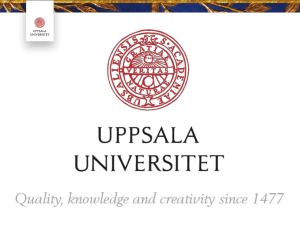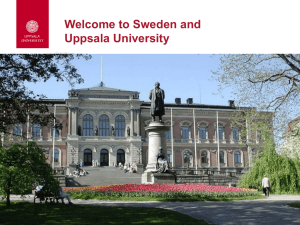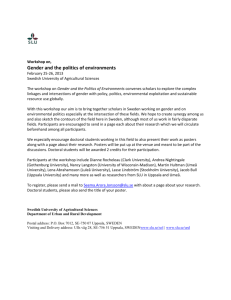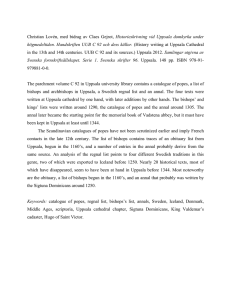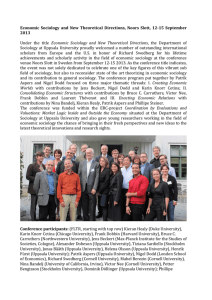MS Word - MGH Neurosurgical Service
advertisement
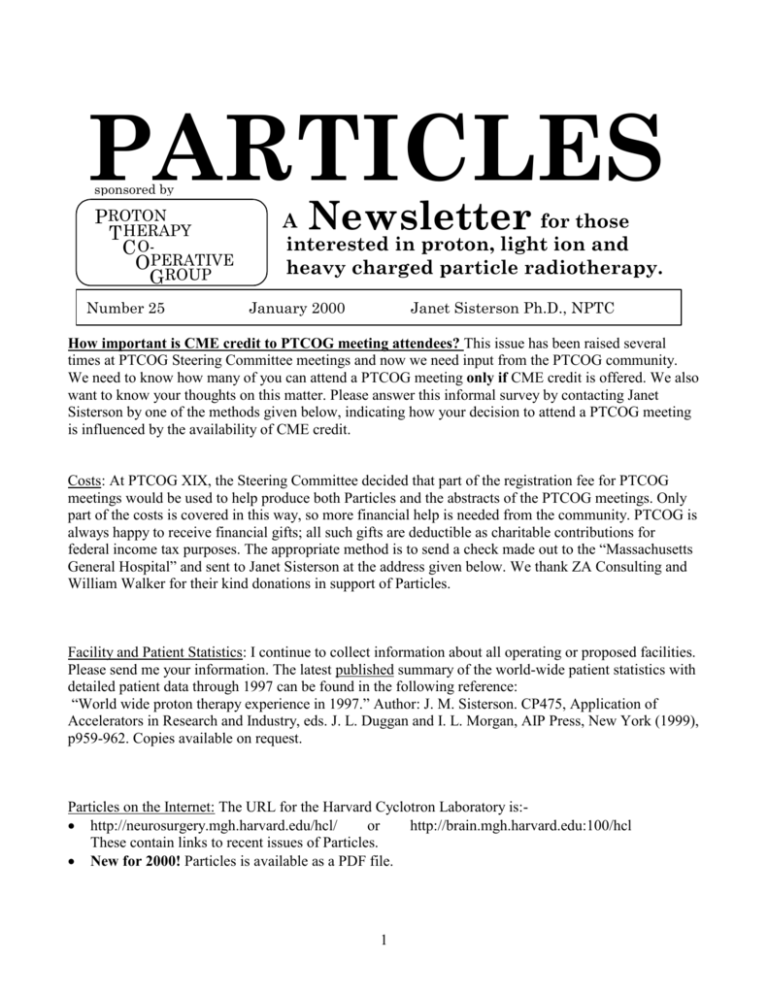
PARTICLES sponsored by PROTON T HERAPY C OOPERATIVE GROUP Number 25 Newsletter A for those interested in proton, light ion and heavy charged particle radiotherapy. January 2000 Janet Sisterson Ph.D., NPTC How important is CME credit to PTCOG meeting attendees? This issue has been raised several times at PTCOG Steering Committee meetings and now we need input from the PTCOG community. We need to know how many of you can attend a PTCOG meeting only if CME credit is offered. We also want to know your thoughts on this matter. Please answer this informal survey by contacting Janet Sisterson by one of the methods given below, indicating how your decision to attend a PTCOG meeting is influenced by the availability of CME credit. Costs: At PTCOG XIX, the Steering Committee decided that part of the registration fee for PTCOG meetings would be used to help produce both Particles and the abstracts of the PTCOG meetings. Only part of the costs is covered in this way, so more financial help is needed from the community. PTCOG is always happy to receive financial gifts; all such gifts are deductible as charitable contributions for federal income tax purposes. The appropriate method is to send a check made out to the “Massachusetts General Hospital” and sent to Janet Sisterson at the address given below. We thank ZA Consulting and William Walker for their kind donations in support of Particles. Facility and Patient Statistics: I continue to collect information about all operating or proposed facilities. Please send me your information. The latest published summary of the world-wide patient statistics with detailed patient data through 1997 can be found in the following reference: “World wide proton therapy experience in 1997.” Author: J. M. Sisterson. CP475, Application of Accelerators in Research and Industry, eds. J. L. Duggan and I. L. Morgan, AIP Press, New York (1999), p959-962. Copies available on request. Particles on the Internet: The URL for the Harvard Cyclotron Laboratory is: http://neurosurgery.mgh.harvard.edu/hcl/ or http://brain.mgh.harvard.edu:100/hcl These contain links to recent issues of Particles. New for 2000! Particles is available as a PDF file. 1 Other proton therapy links: Northeast Proton Therapy Center: http://www.mgh.harvard.edu/depts/nptc/nptc.htm CPO, Orsay, France: http://www-sop.inria.fr/epidaure/personnel/bondiau/CPO_base/cpo_base.htm LLUMC, California: http://www.llu.edu/proton U of California, Davis: http://crocker.ucdavis.edu/cnl/research/eyet.htm Midwest Proton Radiation Institute: http://www.iucf.indiana.edu National Association for Proton Therapy: http://www.proton-therapy.org/ Prolit - database of particle radiation therapy: http://proton.llu.edu TRIUMF, Canada protons: http://www.triumf.ca/welcome/proton_thrpy.html TRIUMF, Canada pions: http://www.triumf.ca/welcome/pion_trtmt.html PSI, Switzerland: http://www.psi.ch/ Proton Oncological Therapy, Project of the ISS, Italy: http://top.iss.infn.it TERA foundation, Italy: http://www.tera.it GSI homepage: http://www.gsi.de The Svedborg Laboratory, Sweden: http://www.tsl.uu.se/ Clatterbridge Centre for Oncology: http://synaptic.mvc.mcc.ac.uk/simulators.html Tsukuba, Japan: http://www-medical.kek.jp/index.html Tsukuba, Japan - new facility plans: http://www-medical.kek.jp/devnewfac.html HIMAC, Chiba, Japan: http://www.nirs.go.jp/ENG/particl.htm (ENG case sensitive) NAC, South Africa: http://www.nac.ac.za/~medrad/ ARTICLES FOR PARTICLES 26 June 30 2000 is the deadline for news for Particles 26, the July 2000 issue. I will send reminders by fax or e-mail. Address all correspondence for the newsletter to: Janet Sisterson Ph.D. Northeast Proton Therapy Center Massachusetts General Hospital 30 Fruit Street Boston MA 02114 Telephone: Fax: E-mail: (617) 724-1942 (617) 724-9532 jsisterson@partners.org Articles for the newsletter can be short but should NOT exceed two pages in length. The best way to send an article is by computer. If you mail or fax an article, remember that I scan them into the computer so I need a good clean copy of any figures. PLEASE, when you send me a file by computer GIVE IT AN UNIQUE TITLE that will indicate to me the source of the article. You have no idea how many files I have on my computer that are called ptles24.doc or something similar!! 2 PTCOG BUSINESS and FUTURE PTCOG MEETINGS Chair: Michael Goitein Department of Radiation Oncology Massachusetts General Hospital Boston MA 02114 Steering Committee Members USA Europe W. Chu U. Amaldi M. Goitein H. Blattmann D. Miller J.-L. Habrand J. Sisterson G. Munkel James Slater E. Pedroni A. Smith A. Wambersie H. D. Suit L. Verhey Secretary: Janet Sisterson Northeast Proton Therapy Center Massachusetts General Hospital Boston MA 02114 Russia V. Khoroshkov Japan K. Kawachi H. Tsujii South Africa D. Jones The times and locations of the next PTCOG meetings are as follows: PTCOG XXXII Uppsala, Sweden April 16 - 19 2000 PTCOG XXXIII *** note location change ** Berlin, Germany September 25 – 27 2000 PTCOG XXXIV Boston, MA, USA Spring 2001 PTCOG is very grateful to all our colleagues in Berlin for agreeing at such short notice to organize PTCOG XXXIII in September 2000. 3 Summary of the Steering Committee Meeting, PTCOG XXXI Tuesday October 12 1999, Indiana, USA. Present: E. Blomquist, W. Chu, D. Errington, M. Goitein, E. Grusell, D. Jones, S. Klein, R. Martin, D. Miller, E. Pedroni, J. Sisterson, H. Suit, M. Wedekind, J. Wilson, L. Yonemoto. 1) Future meetings: Definite April 16 - 19 2000: Uppsala, Sweden Tentative Fall 2000: TERA; Lake Maggiore, Italy. Spring 2001: Boston, USA Fall 2001: Tsukuba, Japan Spring 2002: Berlin, Germany No representatives of the TERA collaboration attended this PTCOG meeting, so at this time we could not establish whether they still wished to host this meetings. As we subsequently learnt, they did not and we are grateful to our German colleagues for agreeing to host this meeting. 2) There will be workshops held on Sunday April 16 2000 before the ‘official’ start of the Uppsala PTCOG meeting. One might be on Monte Carlo methods. Several topics were suggested for focus sessions. 3) CME credit: Susan Klein discussed the experience of offering CME credit at this PTCOG meeting. The pre-requisites for providing CME credit are determined by the institution offering it. At Indiana this was the Medical School, who wanted the program fixed 6 months ahead of time and insisted on looking after the registration. Also, because the meeting is required to have a faculty, in essence every speaker becomes a member of the faculty. Although there were some problems, on the whole it seemed to work. The issue is really important for physicians, particularly for those working for HMOs. Jenny Wilson felt that in the future it would be essential for PTCOG meetings to offer CME credit. Bill Chu was very concerned that regulations might constrain the free discussions that are possible at the present PTCOG meetings. It was resolved at present to: Let the host institution decide whether to offer credit or not. Use disclosures with discretion. Conduct a survey via Particles to see how many people can attend ONLY if CME credit is offered. See Page 1 of this issue of Particles. 4) Funding for Particles. PTCOG needs to become more aggressive in collecting the dues to fund the production of Particles, in seeking out gifts, and in investigating ways electronic publishing. 4 PTCOG XXXII April 16-19 2000. Uppsala, Sweden Uppsala welcomes you with an atmosphere of tradition and inspiration! For more than 500 years, Uppsala has provided an inspiring environment for the advancement of science, literature and art. Carolus Linnaeus, Ingmar Bergman and Dag Hammarsköld are among those who have lived and worked here. Uppsala University was founded in 1477, and the beautiful Main Building, was inaugurated in 1887. Today Uppsala University has more than 30.000 registered students. In addition, the Swedish University of Agricultural Sciences also resides in Uppsala. Also, when in Uppsala, take the opportunity to visit the Dome of Uppsala, the largest cathedral in Scandinavia. It was inaugurated in 1435 and provides a very impressive example of gothic architecture. Other sights are the Gustavianum with its Anatomical Theatre and the art cabinet of Augsburg, the University Library Carolina Rediviva with the Silver Bible, and the Linnaeus Garden. Uppsala Castle, venue of PTCOG XXXII, as well as the burial mounds of pagan kings at Old Uppsala hold dramatic events in their past. General information: Scientific secretaries Erik Blomquist MD, PhD, Assoc.Prof Erik Grusell PhD Dept. of Oncology Dept. of Hospital Physics Uppsala University Akademiska sjukhuset SE-751 85 Uppsala, Sweden Telefax: +46-(0)18-50 87 24 E-mail: erik.blomquist@onkologi.uas.lul.se Erik.Grusell@asf.uas.lul.se Presentations and Posters: Please send the title of your presentation to one of the scientific secretaries before the end of March. All talks will be a maximum of 12 minutes including time for discussion. If the session is full, speakers will be informed and asked to consider a poster presentation. The maximum size for a poster is 1.0 x 1.8 meters. Presenters are encouraged to send an abstract of their presentation to both the conference organizers and Janet Sisterson (jsisterson@partners.org). The abstracts will be published with the next issue of Particles in July 2000. Abstracts should be no more than one half page in length. Registration: Please use the enclosed Registration Forms to register for the congress and the social program, and for hotel reservations. Before March 1 2000 the fee is SEK 1800; after March 1, SEK 2000. No personal cheques accepted; methods of payment are given on the registration form. Registration fees will be refunded (less SEK 500) for cancellations made before March 31 2000. Currency The official congress currency is SEK, Swedish Kronor - the exchange rate as of December 14, 1999 was: SEK 100 = USD 1166; SEK 100 = EURO 1161 Special requirements: Anyone requiring special arrangements in order to fully participate in the congress should enclose a written description of the needs together with the completed registration form. 5 Accommodation: Uppsala Turist & Kongress AB (UTKAB) has made block-bookings at hotels of different categories in Uppsala. (Please see hotel-listing below) The congress venue, Uppsala castle, is within walking distance of all the hotels. Since only a limited number of hotel rooms have been reserved in each category, rooms will be distributed on a first-come first-served basis. Please mark your 1st, 2nd and 3rd choice. If the category you wish to book is complete, a room of your next preference will be booked. Please note that all changes concerning accommodation must be made through Uppsala Turist & Kongress, "XXXII PTCOG", Fyristorg 8, 753 10 UPPSALA, Sweden. Fax no.+46-18-69 24 77, e-mail: kongress@utkab.se Radisson SAS Hotel Gillet: located downtown Uppsala. www.radisson.com Single room: SEK 1.390/700* Double room: SEK 1.1650/900* First Hotel Linné: located by the Linneaus Garden. www.firsthotels.com Single room: SEK 1.148/748* Double room: SEK 1.398/748* Hotel Svava: located in the centre of Uppsala. www.hotelsvava.com Single room: SEK 1.195/650* Double room: SEK 1.395/790* Grand Hotel Hoernan: located by the Fyris River. www.eklundshof.se Single room: SEK 930/650* Double room: SEK 1.150/800* Tariffs quoted are per room per night and incl. sheets, breakfast and VAT, if not otherwise specified. *Prices given are weekend rates and will be applied only Friday and Saturday night! Prices are subject to adjustments. All hotels offer private bath/shower/WC, telephone, radio and TV. Payment for accommodation should be made directly to the hotel when checking out. Cash and credit cards are accepted. Hotel check-in time is 15:00 or later. If arriving after 18:00, please notify the hotel. Check-out time is 12:00. If you arrive early in the morning it is possible that your room will not be ready for immediate occupation on your arrival. Should you feel it necessary, you can ensure immediate availability by paying an extra day's tariff thus booking your room for the night before your arrival. Please advise the congress secretariat if you wish to take this precaution. Cancellation of your reservation must be made one week in advance to Uppsala Turist & Kongress or you will be charged for the first night. Confirmation of registration and hotel reservation: Will be sent out in March (week no. 12) 2000. Congress secretary:Congress Bureau “XXXII PTCOG” Uppsala Turist & Kongress AB, Fyris torg 8 SE-753 10 Uppsala, Sweden. Telephone: +46-(0)18-27 48 07 Telefax: +46-(0)18-69 24 77 E-mail: kongress@utkab.se Congress website: Congress program in detail, hotel and travel information, guided tours, sponsors and more will currently be added at http://www.uas.se/fakta/ext/medkurs.htm Guided tour: On April 18, 16.30-18.00 there will be a guided city walk in Uppsala for participants and accompanying persons. Meeting point Uppsala Castle. During this walk through some of the old parts of 6 the town we will visit historical buildings such as Uppsala Cathedral, Gustavianum (with the University Museum) and the University Main Building. SEK 65/person. Min. 25 people. Exhibitions: Scientific posters, commercial exhibits of industrial hardware and software. Details on the web site. Preliminary Program 16 Sunday Workshop: Monte Carlo Techniques in Dose-planning Moderator: Anders Ahnesjö Morning 17 Monday Monday Evening: 18 Tuesday Afternoon Radiobiology and Benign targets Dose-planning (Glimelius) Tour of The Svedberg Laboratory and Welcome buffet Steering Committee Breakfast Gantry Design and dosimetry Tuesday Evening: Cultural tour and Conference dinner 19 Wednesday General Clinic “Pediatric Protons” (Hug) PTCOG Business Meeting General Physics Links to more information about Sweden: Please visit the following Internet sites: http://www.tourist.se/ (Information about Sweden) http://www.travlang.com/languages/ (Learn the Swedish language) http://www.svenska-sidor.com/ (The Swedish Page) http://www.forex.se/ (Exchange rates) www.nobel.se (The Nobel Prize Archive) www.sverigeturism.se (What to see and where to stay in Sweden) Time: Sweden is 1 hour ahead of Greenwich Mean Time (GMT). Tourist Information: Tourist Information, Fyris torg 8, SE-753 10 Uppsala, Sweden. Telephone: +46-(0)18-27 48 00 Telefax: +46-(0)18-13 28 95 Website: www.res.till.uppland.nu; this website includes a map of Uppsala Travel to and from Sweden and Uppsala: Arlanda International Airport is served by more than 700 flights daily to and from more than 100 cities in 50 countries. It is located approximately 35 kilometres south of the center of Uppsala. During peak hours the airport coach, #801 (www.upplandslokaltrafik.se) leaves 2-4 times per hour to and from Uppsala. The transfer takes about 45 minutes and costs SEK 75 (December 1999). There are also several taxi companies operating from the airport. If you intend to take a taxi, we recommend you to always agree a fare in advance. Sweden also has a comprehensive railway system including high-speed trains to all the major Swedish cities as well as to destinations abroad. Furthermore, there are daily ferries to and from Finland and Estonia. 7 Weather: The climate in April can be quite changeable with nice and sunny spring weather but also some rain. Average temperature ranges from approx. 10-15 C. As Uppsala Castle is a medieval building, we recommend that you bring a sweater, should you find it chilly. First Announcement: PTCOG XXXIII 25-27 September 2000 Berlin, Germany Organisation: Hahn-Meitner Institut Berlin Glienicker Str. 100 D-14109 Berlin, Germany Contact: Mrs. Gisela Liar de Martin, Mrs. Viola Lange Tel: +49 30 8062 2415 Fax: +49 30 8062 2097 e-mail: ptcog@hmi.de (available from January 2000) Date: 25-27 September 2000 Venue: Hotel Steglitz International, Berlin Latest Information: http://www.hmi.de/events The PTCOG XXXIII will be held in conjunction with the European Cyclotron Progress Meeting (ECPM XXXII from September 21-23, location: Hotel Steglitz International). The ECPM is devoted to cyclotrons and their applications, and it will have an informal character. Although the meeting will include review presentations and descriptions of existing machines and equipment, its participants should focus on novel solutions, new ideas and unsolved problems. A first circular for both meetings will be sent out in February 2000. 19th International Conference on Atomic Collisions in Solids 29 July - 3 August 2001 Paris, France ICACS is a biannual meeting, which deals with physical and chemical phenomena induced by the interaction of low and high energy beams of charged or neutral particles with matter: solids, liquids and biomaterials. The most recent meetings have been held in Odense (Denmark, 1999) and Beijing (China, 1997). The objectives of the Paris ICACS-19 are to assess the state of the art in the current understanding of a variety of phenomena such as radiation damage, electron emission, energy losses of ions, etc. While the programme will focus mainly on the interaction of atomic, molecular and cluster projectiles, related processes induced by electron, positron and photon beams, will also be considered. Pertinent materials are various solids, polymers, bio-materials and liquids. New developments in 8 experimental techniques may be presented. The emphasis of the meeting is on fundamental processes, but applications in physics, chemistry, biology and medicine will be considered. Thus use of ion beams in cancer treatment and inactivation and mutation effects induced by hydrogen and heavy ion beams in cells may be considered. This rather wide programme will be of interest to the members of the PTCOG community interested in various fundamental aspects of primary and secondary effects of ion beams over a very wide range of energies extending through and beyond the Bragg peak region. The programme will consist of oral and poster presentations and sufficient time for informal discussions will be allocated. Interested persons should pre-register at the ICACS website in order to receive further information. Contact : Vladimir A.Esaulov, Chairman Laboratoire des Collisions Atomiques et Moleculaires bat.351, Universite de Paris Sud 91405 Orsay Cedex France phone : (33)1 69 15 76 80 fax : (33) 169 15 76 71 e-mail : icacs19@veof1.lcam.u-psud.fr http://veof1.lcam.u-psud.fr/idc/icacs19.html PTCOG Information/News/Reports: The following reports and articles were received by January 2000. Tumortherapy at GSI, Darmstadt, Germany: A status report In December 1997, the first two patients were treated at GSI with a carbon-ion beam. Following these pilot irradiation, a clinical study started in August 1998. The aim of this clinical study is to demonstrate the superiority compared to conventional photon irradiation of ion-beam therapy for selected indications. Beams of heavy-charged particles, such as carbon ions, produced a significantly more favourable dose distribution, allowing an increase in tumour dose while sparing healthy tissue. In addition, ions have a higher biological effectiveness in destroying the tumour. For these reasons ion beam therapy is recognised as particular appropriate for the treatment of inoperable tumours in the vicinity of high-risk organs like the brainstem as well as of photon irradiation-resistant tumours. In the framework of the clinical study, 46 patients have been treated so far. The eligible indications comprise: chordoma and chondrosarcoma of the scull base, adenoidcystic carcinoma, anaplastic and malignant meningeoma, and malignant schwannoma. 23 out of 46 patients were treated solely with heavy ions during 20 consecutive days. The other patients received a stereotactic photon irradiation treatment at the University Hospital of Heidelberg and the German Cancer Research Centre (DKFZ) in Heidelberg, respectively. The photon therapy was then complemented by a boost-irradiation with five to six carbon ion fractions at GSI. All 46 patients could be treated according to plan without any severe complications. Ever since they undergo regular follow-ups at the University Hospital Heidelberg and the DKFZ in order to monitor the outcome of the treatment and possible side effects caused by the irradiation. So swelling of the mucous membrane occurred in a few cases. However, these cases were in accordance with expectations from radiobiological estimates and could be treated successfully, if necessary at all. 9 For 42 of the 46 patients treated so far, the course of disease is rather favourable with no indication of a recurrence of the tumour within the area irradiated with heavy ions. For the other four patients, complications occurred that were, however, not connected to a recurrence of the primary tumour. One patient passed away, but again this was not due to the primary tumour that had even shown a strong reduction after the treatment. Despite the very promising results obtained so far, it is still too early to draw final conclusions on the clinical significance of ion-beam therapy. This will require considerably higher patient numbers and much longer follow-up periods of the patients treated. The clinical studies will, therefore, be continued during the next years. In addition, other indications, e.g. tumours in the vicinity of the spinal chord or in the abdominal region, shall be included into the study. Because of the positive results of this pilot project at GSI, the plans for a realisation of a dedicated proton/ion center at the Radiological Clinic in Heidelberg make good progress. The plans to construct this center were approved by the Heidelberg University as well as by the University Hospital. The scientific advisory committee of the federal government (Wissenschaftlicher Rat) gave a positive vote for the allocation of DEM 2 mio for a detailed planning that will be performed within this year by the construction department of the Heidelberg University and the accelerator division of GSI. In fall 2000 these detailed plans will allow a rigorous cost estimate as basis for the financing In addition, DEM 8.75 mio were allocated by the Helmholtz-Society in order to develop a multifield irradiation facility for ion beams. With this support the construction period could start by the end of this year and first patient treatments at Heidelberg are expected to begin five years later. Chairman of the project is Dr. Dr. J. Debus at the DKFZ in Heidelberg. The German Helmholtz-Society (HGF) has given the Erwin-Schrödinger award for the development of the heavy-ion tumortherapy to Gerhard Kraft (GSI Darmstadt), Wolfgang Enghardt (FZR Rossendorf) and Jürgen Debus (Radiology and DKFZ Heidelberg). The Roentgen award of the University of Giessen was given to Michael Scholz (GSI Darmstadt) for the development of the local effect model that calculates RBE on the basis of X-ray data. The new Christoph Schmelzer award for the best PhD thesis concerning heavy-ion tumortherapy was splitted between Catherina Brusasco from INFN Turino and Kathrin Lauckner from FZR Dresden. G. Kraft, GSI, Planckstrasse 1, Darmstadt, D 64291, Germany. FDA approval and Medicare coverage and payment issues in proton beam therapy: FDA Approval: The FDA approves medical devices for “marketing”. There are three alternative routes to obtain FDA approval to market medical devices. The pre-market approval application (“PMA”) process involves a full-scale review of a device’s safety and efficacy by the FDA. The second route to market is a rarely used one known as the “custom device exemption”. It is intended for devices used by a single practitioner (such as a custom surgical device) and is not applicable to proton beam therapy. The third route to market is referred to as “substantial equivalency” or the 510(k) process - a reference to the relevant section of the Medical Device Amendments. In 1987, Loma Linda University Medical Center (“LLUMC”) acting as the manufacturer of its proton beam therapy system submitted a 510(k) pre-market notification for its proton beam therapy system. Massachusetts General Hospital (“MGH”) is developing its Northeast Proton Therapy Center (“NPTC”). As the manufacturer of their system, they submitted a 510(k) pre-market notification to the FDA in 1998. Lastly, Proton Therapy Corporation of America (“PTCA”), a subsidiary of Tenet HealthSystem, has contracted with Ion Beam Associates (“IBA”) of Belgium to manufacture proton beam therapy systems for facilities PTCA is developing across the country. IBA also submitted its pre-market notification to the FDA in 1998. Medicare Coverage: As the largest payor for health care services in the United States, the Medicare program is the “gold standard” for issues related to coverage and payment by payors of all types. 10 To understand the impact of the Medicare program on proton beam therapy, it is important to distinguish between coverage and payment. Coverage is the process by which the Medicare program determines that a service is “necessary and reasonable”. Interestingly, coverage does not necessarily guarantee payment although payment cannot be made to a provider (with the exception of a few circumstances) unless it is a covered service. As such, approval by the Medicare program that a service is “covered” is a necessary precursor to payment. Coverage decisions by the Medicare program can be made at one of two levels – nationally or locally. Until recently, there was no formal process for making national coverage decisions. However, in April of this year the Health Care Financing Administration (“HCFA”) released details on its national coverage process which will “streamline our decision making process and . . . increase the opportunities for public participation in making national coverage decisions.” This national coverage process involves a variety of steps and involves several recently appointed (or to be appointed) advisory panels. The alternative approach for obtaining Medicare coverage is a decision by a local Medicare contractor, -a local or regional entity contracted by the Medicare program to administer benefits in each geographic region. Under the provisions of Medicare regulations, the various Medicare contractors are encouraged to make coverage decisions on behalf of the Medicare program – particularly where a service such as proton beam therapy is not widely available throughout the nation. Local Medicare coverage decisions are made via a process which is not as “rigorous” as that described in the new Medicare national coverage process. In general, although subject to wide variations, coverage decisions made by contractors are made by the Carrier Medical Director (“CMD”) and his/her staff with the input and advice of a Carrier Advisory Committee (“CAC”). The latter is an advisory group appointed by each carrier consisting of representatives of medical specialties, associations, other insurers, consumers, regulators, etc. Depending on the specific Medicare contractor, this can be a fairly rigorous process or a very informal one. Once proposed coverage decisions are made by a local carrier, they are provided for comments to representatives of relevant medical specialties and others who offer their advice to the Carrier Medical Director. They are then published in the Carrier’s local medical bulletin at which point they are open for comment by providers and others. There is also an informal Carrier Medical Director working group that facilitates the interchange of information among the various Carrier Medical Directors. Medicare Fee Setting: Once coverage for a new procedure is approved – fee setting by Medicare takes place. This can occur in one of several ways depending on how coverage for the new procedure was approved. As the new Medicare national coverage process has not been in place for very long, it is not yet clear how HCFA will set fees for new procedures for which coverage was approved through this national process. We anticipate that such fees will be set by HCFA with the “advice and counsel” of relevant professional organizations. When coverage is approved at the local contractor level, fees are typically set and negotiated directly with that fiscal intermediary or carrier based on a number of factors including costs, Medicare fees for comparable procedures (should they exist) and considerations of cost effectiveness. CPT Coding: In general, an appropriate CPT code is necessary to facilitate the Medicare program (as well as other insurers) paying for services (although it is possible to be paid by the Medicare program using either unlisted procedure codes or “local codes” are established by local contractors to pay for services when no code has been established and published in the American Medical Association’s CPT Manual). 11 As the result of efforts initiated by Massachusetts General Hospital with the support of LLUMC and PTCA, the AMA’s Committee on Nomenclature approved two new CPT codes for inclusion in the 1999 CPT manual as follows: 77380 77381 Proton beam delivery to a single treatment area, single port, custom block, with or without compensation, with treatment set-up and verification images. Proton beam treatment to one or two treatment areas, two or more ports, two or more custom blocks, and two or more compensators, with treatment set-up and verification images. In response to additional efforts involving MGH, LLUMC, PTCA and Indiana University, the AMA recently approved modifications to these codes as well as several additional codes for the year 2001 CPT manual. These modified and new codes will be as follows: Definitions Simple proton treatment delivery to a single treatment area utilizing a single non-tangential/oblique port, custom with compensation (7752X1), and without compensation (77520). Intermediate proton treatment delivery to one or more treatment areas utilizing two or more ports or one or more tangential/oblique ports, with custom blocks and compensators. Complex proton treatment delivery to one or more treatment areas utilizing two or more ports per treatment area with matching or patching fields and/or multiple isocenters, with custom blocks and compensators. 77520 7752X1 77523 7752X2 Proton treatment delivery; simple, without compensation, simple, with compensation intermediate complex Conclusion: Organizations considering the development of proton beam therapy facilities are advised to clearly and fully analyze the alternatives available to them with respect to FDA approval as well as understand their alternatives for obtaining Medicare coverage and the setting of fees. In light of the high capital costs and requisite investment required to develop a facility for the routine clinical provision of proton beam therapy such a thorough analysis and evaluation of alternatives to obtain Medicare coverage and payment at an acceptable level must be a key part of the early planning stages of any new proton beam therapy facility. Alan E. Morrison, Managing Director and Kristen Burks Clark, Managing Associate, ZA Consulting, LLC, 101 West Avenue; Suite 300; Jenkintown, PA 19046; Telephone (215) 517-4900; Fax (215) 572-5970; amorrison@zaconsulting.com; kclark@zaconsulting.com. 12 TREATMENT PLANNING SYSTEMS FOR PROTON THERAPY January 2000 The following Table was presented in October 1999by Skip Rosenthal, MGH at the Workshop on Treatment Planning Systems, PTCOG XXXI. Information was provided by: S. Rosenthal, A. Mazal, M. Collier, T. Lomax, S. Nill, and D. Miller. This Table is a new feature of Particles, and will be updated each issue. Please send corrections/additions to Janet Sisterson. Year 1979-93 1980 1980 1990-96 198?,1991 1995 1996 1997 1998 1998 1994 1998 1998 199? Created By System Name Status LBL MGH MGH MGH/Seimens PSI DKFZ/Royal Marsden Radionics/MGH/HCL LLUMC/Permedics Tsukuba DKFZ Orsay/Curie CMS/MGH DKFZ Uppsala/KVI RenderPlan Adac Michigan Varian LBL system Rx EYEPLAN V-Treat(AXIOM) PSI system/Pion Voxelplan/Proxelplan P-Knife Optrad 3D Hitachi system OCTOPUS ISIS FOCUS KonRad Plus Protons Helax (+ protons) Not Available Distributor MGH Distributor MGH – EYES only Not Available Distributor PSI Adapted by GSI, NAC, DKFZ Not Available Commercial Pending FDA In-house system Used in Berlin – EYES only Distribution ? Commercial Release 1999 Research Only Distribution ? ? ? ? ? Proposed NEW FACILITIES for PROTON & ION BEAM THERAPY - January 2000 INSTITUTION PLACE INFN-LNS, Catania NPTC (Harvard) Hyogo NAC, Faure Tsukuba CGMH, Northern Taiwan Wakasa Bay Bratislava IMP, Lanzhou Italy MA USA Japan South Africa Japan Taiwan Japan Slovakia PR China Shizuoka Cancer Center Erlangen CNAO, Milan & Pavia Heidelberg AUSTRON Beijing Central Italy Clatterbridge TOP project ISS Rome 3 projects in Moscow Krakow Proton Development N.A. Inc. PTCA, Tenet HealthSystem Japan Germany Italy Germany Austria China Italy England Italy Russia Poland IL USA USA TYPE p p p, ion p p p p, ion C-Ar ion p p, ion p, ion p, ion p p p p p p p p 1ST RX? 2000 2000 2001 2001 2001 2001? 2002 2003 2003 COMMENTS 70 MeV; 1 room, fixed horiz. beam at MGH; 230 MeV cyclotron; 2 gantries + 2 horiz 2 gantries; 2 horiz; 1 vert; 1 45 deg;under construction new treatment room with beam line 30o off vertical. 270 MeV;2 gantries;2 fixed (research);under construction 250MeV synchrotron/230MeV cyclotron;3 gantry,1 fixed multipurpose accelerator; building completed mid 1998 72 MeV cyclotron; p; ions; +BNCT, isot prod. C-ion from 100MeV/u at HIRFL expand to 900 MeV/u at CSR;clin. treat;biol. research;no gantry;shifted patients 2002? synchrotron 230? MeV; 2 gantries; 1 horiz; funded. 2002? 4 treatment rooms, some with gantries. 2004? synchrotron; 2 gantry;1 fixed beam rooms;1 exp. room 2005? ? 2p gantry;1 ion gantry;1 fixed p;1 fixed ion;1 exp room ? 250 MeV synchrotron. ? cyclotron; 1 gantry; 1 fixed ? upgrade using booster linear accelerator to 200 MeV? ? 70 MeV linac; expand to 200 MeV? ? including 320 MeV; compact, probably no gantry ? 60 MeV proton beam. ? 300 MeV protons; therapy & lithography ? Several systems throughout the USA 13 WORLD WIDE CHARGED PARTICLE PATIENT TOTALS January 2000 WHO WHERE WHAT DATE DATE FIRST LAST RX RX Berkeley 184 Berkeley Uppsala Harvard Dubna Moscow Los Alamos St. Petersburg Berkeley Chiba TRIUMF PSI (SIN) PMRC, Tsukuba PSI (72 MeV) Dubna Uppsala Clatterbridge Loma Linda Louvain-la-Neuve Nice Orsay N.A.C. MPRI UCSF - CNL HIMAC, Chiba TRIUMF PSI (200 MeV) G.S.I Darmstadt Berlin NCC, Kashiwa CA. USA CA. USA Sweden MA. USA Russia Russia NM. USA Russia CA. USA Japan Canada Switzerland Japan Switzerland Russia Sweden England CA. USA Belgium France France South Africa IN USA CA USA Japan Canada Switzerland Germany Germany Japan p He p p p p p heavy ion p p p p p p p p p p p p p heavy ion p p heavy ion p p 1954 1957 1957 1961 1967 1969 1974 1975 1975 1979 1979 1980 1983 1984 1987 1989 1989 1990 1991 1991 1991 1993 1993 1994 1994 1995 1996 1997 1998 1998 RECENT PATIENT TOTAL — 1957 — 1992 — 1976 — 1974 — 1982 — 1992 — 1994 — 1993 – 1993 TOTAL The Proposed Facilities List is on the previous page. 14 30 2054 73 8372 84 3100 230 1029 433 96 367 503 629 3014 43 215 960 4726 21 1350 1522 341 34 246 473 55 41 46 105 18 1100 3006 26104 30210 DATE OF TOTAL June-91 Dec-99 Dec-98 Jun-98 June-91 Oct-96 Dec-93 Jul-99 Dec-99 Dec-99 Oct-99 Dec-99 Dec-99 Jun-99 Sept-99 Dec-99 Dec-99 Dec-99 Sept-98 Dec-99 Dec-99 Dec-99 Dec-99 Dec-99 pions ions protons all particles
